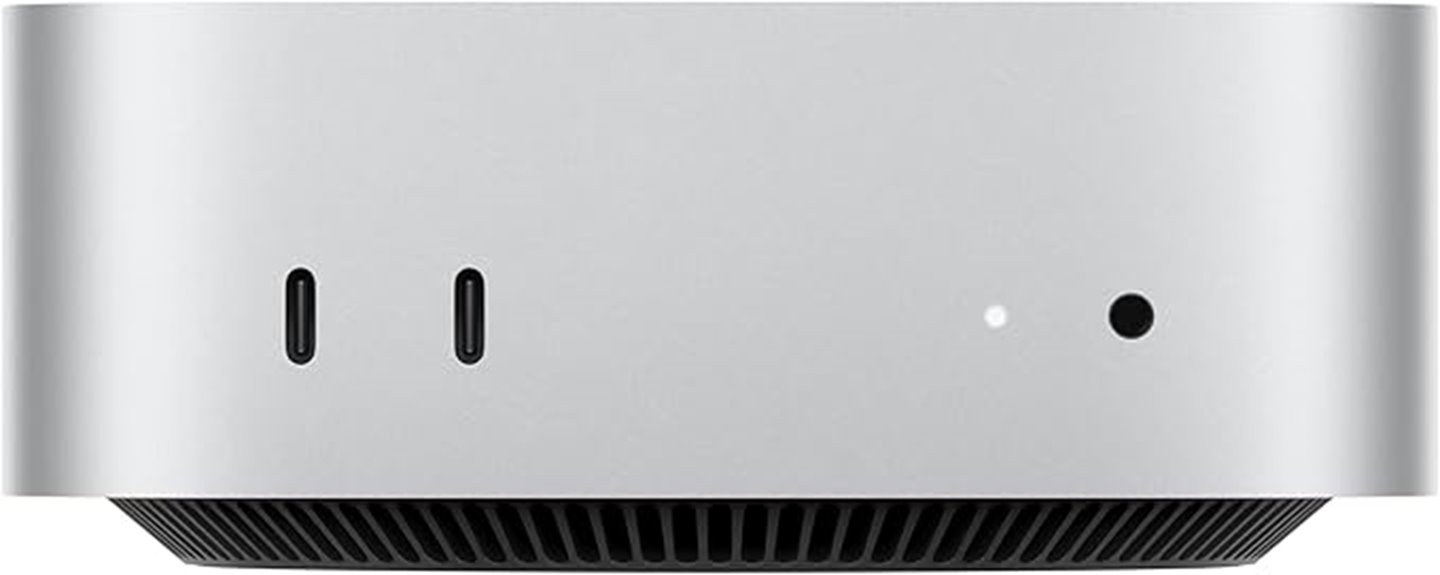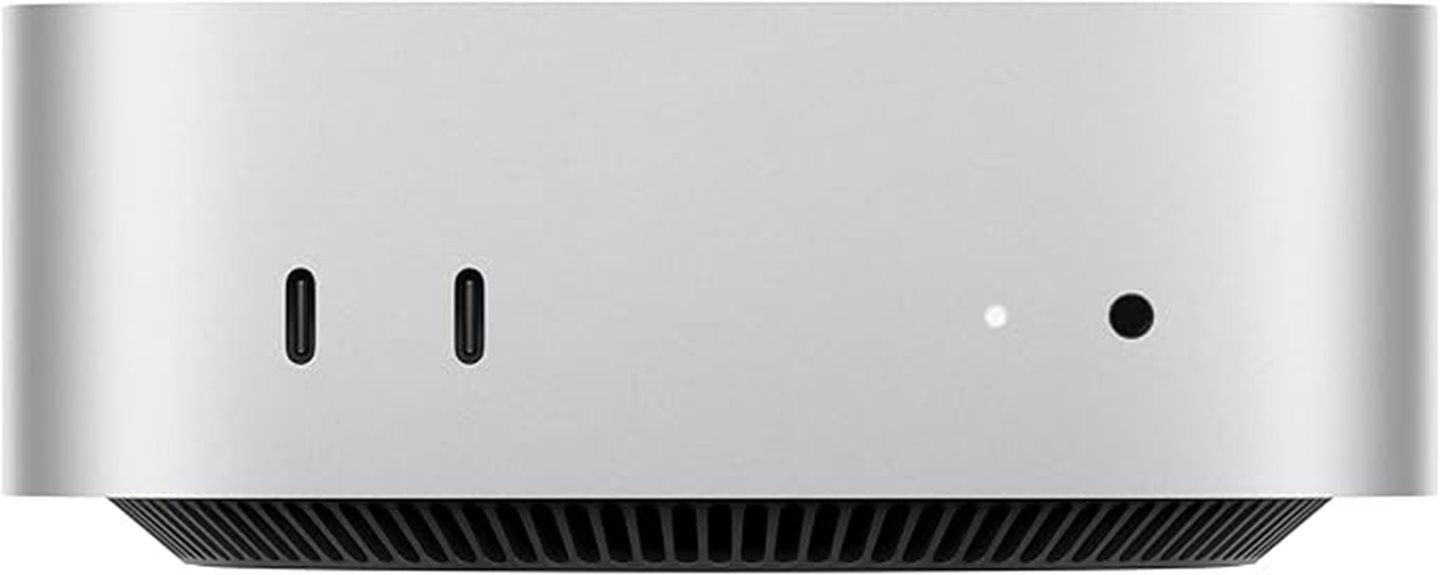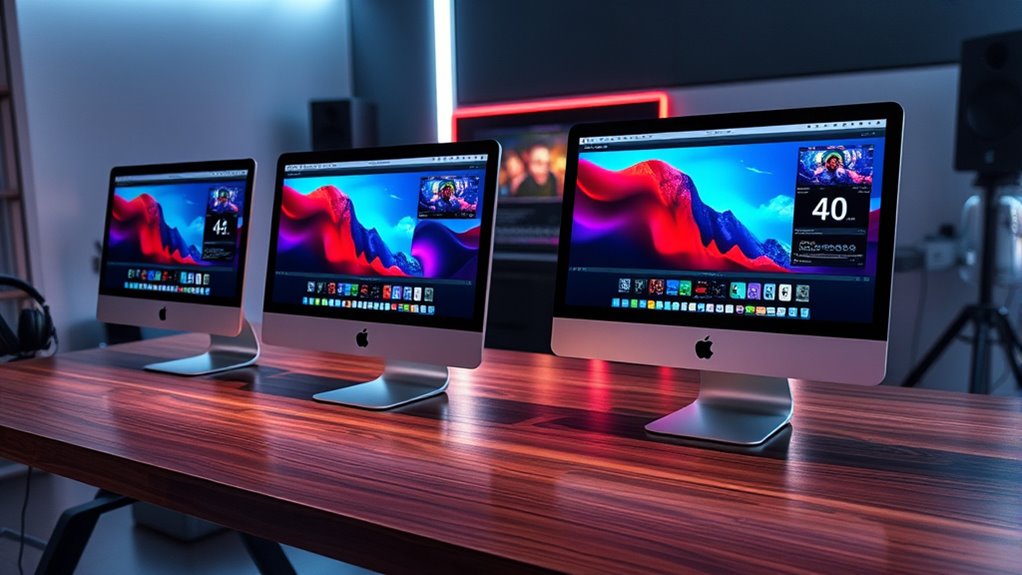For 2025, I recommend the top four Mac Studio models for video editing, focusing on power, performance, and precision. These include options with M4 Pro and M4 Max chips, which offer advanced multi-core CPUs and high-performance GPUs for handling 4K and 8K projects effortlessly. With ample storage, fast RAM, and robust connectivity, these models are built for demanding workflows. Keep going, and you’ll discover which one best fits your editing needs.
Key Takeaways
- Select models with M4 Pro or M4 Max chips for optimal processing and graphics performance in 4K, 6K, and 8K video editing.
- Prioritize configurations with up to 2TB SSD storage and at least 16GB RAM, expandable up to 24GB or more for demanding workflows.
- Ensure multiple Thunderbolt 4 or USB-C ports for high-speed data transfer, external displays, and peripheral connectivity.
- Choose models supporting high-resolution external displays (6K/8K) with hardware acceleration for precise visuals and HDR workflows.
- Balance performance needs with budget, considering the limited upgrade options for storage and RAM post-purchase.
Apple Mac mini Desktop Computer with M4 Chip (256GB SSD, 16GB RAM)

If you’re looking for a compact yet powerful desktop for video editing, the Apple Mac mini with the M4 chip is an excellent choice. Its five-by-five-inch design makes it incredibly space-efficient, fitting easily beside monitors or in tight spaces. Despite its small size, it packs a punch with a 10-core CPU, 10-core GPU, and 16-core Neural Engine, ensuring smooth editing workflows. With 16GB of unified memory and a fast 256GB SSD, it handles demanding tasks well. Connectivity options include Thunderbolt 4, HDMI, and multiple USB-C ports, supporting multiple displays and high-speed peripherals. It’s quiet, energy-efficient, and perfect for creative professionals needing power in a tiny package.
Best For: creative professionals and users seeking a compact, powerful desktop for video editing, digital art, or home office tasks.
Pros:
- Small, space-saving design that fits seamlessly into any workspace
- Powerful M4 chip with 10-core CPU and GPU for smooth multitasking and demanding creative workflows
- Quiet operation with high energy efficiency, making it suitable for prolonged use
Cons:
- Limited internal storage at 256GB, which may require external drives for larger files
- No user-upgradable RAM or storage, limiting future expansion options
- Port placement on the back can be less accessible, especially in tight setups
Apple Mac mini Desktop Computer with M4 Chip (2024)

The Apple Mac mini Desktop Computer with M4 chip (2024) stands out as an excellent choice for video editors who need powerful performance in a compact form factor. Its 10-core CPU and GPU deliver fast, smooth editing, while 16GB of unified memory guarantees multitasking runs seamlessly. The device supports up to three high-resolution displays, perfect for detailed workflows. With hardware-accelerated ray tracing, media engines for H.264, HEVC, and ProRes, and lightning-fast 120GB/s memory bandwidth, it handles demanding tasks effortlessly. Its small size and extensive connectivity options make it versatile for any workspace, all while seamlessly integrating into the Apple ecosystem.
Best For: creative professionals and power users who need a compact, high-performance desktop capable of handling demanding tasks like video editing and multitasking within the Apple ecosystem.
Pros:
- Compact size with a sleek design that fits easily on any workspace
- Powerful M4 chip with 10-core CPU and GPU for smooth, efficient performance
- Supports up to three high-resolution displays, ideal for detailed workflows
Cons:
- Limited upgrade options for memory and storage after purchase
- Only three ports at the back, which may require additional hubs for extensive peripherals
- Premium price point may be a consideration for budget-conscious buyers
Apple 2024 Mac mini Desktop Computer with M4 Chip

Designed for those who need powerful yet compact hardware, the Apple 2024 Mac mini with M4 chip delivers impressive performance in a small form factor. Its 5×5 inch size and 2-inch height make it easy to place next to your monitor without clutter. Despite its tiny exterior, it packs a 10-core CPU, 10-core GPU, and hardware-accelerated ray tracing, ensuring smooth video editing workflows. With 24GB of unified memory and fast SSD options up to 2TB, it handles demanding tasks effortlessly. Its versatile ports—including Thunderbolt 4, HDMI, and USB-C—support multiple displays and peripherals, making this mini a surprisingly powerful powerhouse for creative professionals.
Best For: creative professionals and power users seeking a compact yet high-performance desktop for demanding tasks like video editing, 3D rendering, and software development.
Pros:
- Compact size fits easily next to monitors, saving desk space
- Powerful M4 chip with 10-core CPU and GPU offers excellent performance for intensive workloads
- Versatile connectivity with multiple ports supports multiple displays and peripherals
Cons:
- Limited upgradability beyond SSD and memory configurations
- May require external accessories for enhanced audio or additional ports
- Premium price point for a compact desktop with high-end features
Apple Mac mini Desktop Computer with M4 Pro chip

For anyone seeking a powerful yet compact computer for video editing, the Apple Mac mini with M4 Pro chip stands out as an excellent choice. Its small, five-by-five-inch design fits easily next to a monitor, saving space without sacrificing performance. The M4 Pro chip offers a 12-core CPU, up to 16-core GPU, and hardware-accelerated ray tracing, making demanding tasks smooth and responsive. With up to 24GB of unified memory and fast SSD storage, it handles editing, encoding, and multitasking effortlessly. Supports multiple high-resolution displays, Wi-Fi 6E, and Thunderbolt 5 ports, ensuring seamless connectivity. It’s reliable, quiet, and perfect for professional or casual video editors alike.
Best For: professionals and enthusiasts seeking a compact, high-performance computer for creative tasks like video editing, coding, and digital content creation.
Pros:
- Small, space-saving design that fits easily next to any monitor
- Powerful M4 Pro chip with up to 12-core CPU and 16-core GPU for demanding tasks
- Quiet operation with efficient energy use and reliable performance
Cons:
- Limited internal storage options without external expansion
- May require additional accessories like external SSDs or upgraded cables for optimal performance
- No dedicated graphics card, which could be a limitation for very intensive gaming or 3D rendering
Factors to Consider When Choosing a Mac Studio for Video Editing

When choosing a Mac Studio for video editing, I consider several key factors to guarantee it meets my workflow needs. Things like processing power, graphics capabilities, storage options, RAM, and connectivity all play a role in making the right choice. Understanding these points helps me pick a model that delivers smooth performance and future-proofing.
Processing Power Needs
Choosing a Mac Studio with the right processing power is essential for efficient video editing, especially when working with high-resolution footage. A multi-core CPU dramatically speeds up rendering times and streamlines your workflow. For 4K or 8K projects, increased CPU cores and robust GPU capabilities are crucial for handling intensive encoding and applying effects smoothly. Supporting multiple high-resolution displays requires a powerful processor to manage real-time playback without lag. Hardware-accelerated ray tracing and advanced media engines in the processor improve rendering quality and speed for complex visual effects. Upgrading to a more powerful CPU, like a Pro chip with additional cores, ensures smoother multitasking and prevents bottlenecks during demanding editing sessions. In short, processing power directly impacts your editing efficiency and final output quality.
Graphics Capabilities
The GPU in a Mac Studio plays a vital role in determining how smoothly your video editing workflow runs, especially with high-resolution footage. A more powerful GPU with additional cores and higher VRAM enhances real-time playback, speeds up rendering, and handles complex visual effects more efficiently. Hardware-accelerated ray tracing and ProRes hardware engines further boost performance, reducing rendering times for demanding projects. The GPU’s ability to support multiple high-resolution external displays, like 6K or 8K monitors, depends on its output bandwidth and capabilities. Compatibility with editing software’s hardware acceleration features directly impacts efficiency, making the right GPU indispensable for a seamless editing experience. Selecting a Mac Studio with robust graphics ensures you can work confidently with the most demanding video projects.
Storage Options
Selecting the right storage options is essential for smooth video editing on a Mac Studio, especially when working with high-resolution footage and large project libraries. I recommend choosing larger internal SSDs, like 1TB or 2TB, to handle demanding files without constant management. Since storage configurations are typically non-upgradable after purchase, it’s important to estimate your future needs based on project size and media quality. External SSDs are also a smart addition, offering expanded capacity and faster access to raw footage, which speeds up load times and rendering. Prioritizing fast SSDs minimizes bottlenecks during intensive editing sessions. Proper storage planning ensures your Mac Studio can support your workflow now and as your projects grow, preventing the need for frequent hardware upgrades.
RAM Capacity
When configuring a Mac Studio for video editing, RAM capacity plays a key role in maintaining smooth performance, especially when working with large files and demanding software. For 4K editing and complex effects, I recommend at least 16GB of RAM. However, professional workflows benefit from 32GB or more to handle multiple applications and large projects seamlessly. Higher RAM reduces the need for disk swapping, which can slow down rendering and playback. Software like Final Cut Pro and Adobe Premiere Pro perform considerably better with increased RAM, especially for caching and real-time editing. Investing in more RAM also future-proofs your setup, ensuring your Mac Studio remains capable as your editing demands grow over time. Overall, ample RAM is essential for efficient, stress-free video editing.
Connectivity Features
Choosing the right connectivity features on a Mac Studio is vital for smooth video editing workflows because fast data transfer and reliable connections save time and reduce frustration. I look for models with multiple Thunderbolt 4 or 5 ports, as these support the high-speed data transfer needed for large files and real-time editing. HDMI or DisplayPort outputs supporting 4K, 6K, or 8K resolution are essential for connecting high-resolution monitors for precise editing and previewing. USB-C ports supporting USB 3.2 or USB 4 ensure quick connections to external drives and peripherals. Ethernet options like 10Gb Ethernet enable fast network transfers for large video files. Additionally, Wi-Fi 6E and Bluetooth 5.3 compatibility facilitate wireless connections, minimizing cable clutter and enhancing overall workflow efficiency.
Display Compatibility
To guarantee your Mac Studio can handle the demands of high-resolution video editing, it’s important to verify that it supports your external display’s resolution and refresh rate, such as 6K or 8K, over Thunderbolt 4 or HDMI. Check that the ports can deliver enough bandwidth for multi-monitor setups without bottlenecks. Compatibility with DisplayPort 1.4 or later assures maximum performance with professional high-res displays. Make sure the GPU and hardware acceleration are capable of managing the display’s native resolution and color profiles for accurate editing. Additionally, consider using external adapters or cables that support advanced display technologies like HDR, Dolby Vision, or wide color gamuts. These guarantee your visuals are precise and consistent, essential for professional video editing workflows.
Software Compatibility
Ensuring your Mac Studio runs the latest macOS version is essential for compatibility with current video editing software, as updates often include important features and security improvements. Compatibility with hardware acceleration in programs like Final Cut Pro, Adobe Premiere Pro, and DaVinci Resolve is also fundamental for efficient editing. Verify that the Mac Studio’s CPU and GPU meet the recommended system requirements for handling high-resolution videos, including 4K and 8K formats, without lag or crashes. Additionally, confirm that it supports external peripherals such as professional monitors, external SSDs, and specialized editing accessories, which are often necessary for a streamlined workflow. Finally, check if the device can run specialized plugins and codecs required for your specific editing workflows, ensuring smooth performance throughout your projects.
Budget Considerations
When selecting a Mac Studio for video editing, budget considerations play a critical role in narrowing down options. Higher-performance models with advanced chips like M4 Pro or M4 Max come at a steep price, which can markedly impact your overall budget. To stay within financial limits, you might need to opt for models with lower configurations or older chips that still meet your editing needs. Keep in mind that external accessories like large external SSDs and professional-grade displays can add to total costs. Limited budgets may also restrict internal storage and RAM, affecting workflow efficiency. While investing in a powerful Mac Studio makes sense for professionals, casual editors might find mid-range models more cost-effective without sacrificing too much performance.
Frequently Asked Questions
How Do Mac Studio Models Compare in Upgradeability for Future-Proofing?
I find that Mac Studio models offer limited upgradeability, mainly because Apple designs them with integrated components. While I appreciate their powerful performance, I know I can’t easily upgrade the RAM or storage later. For future-proofing, I prefer choosing a model with higher specs upfront. That way, I guarantee my machine stays relevant longer, even if I can’t upgrade it later myself.
What Are the Best Peripherals to Complement a Mac Studio for Editing?
If you want to enhance your Mac Studio for editing, I recommend investing in a high-quality external monitor, a precise mouse or trackpad, and a reliable external SSD for fast storage. A calibrated display helps guarantee color accuracy, while a good mouse or trackpad boosts workflow. An external SSD keeps your projects accessible and speeds up rendering. These peripherals make editing smoother and more efficient, giving you professional-grade results.
How Does Thermal Management Impact Performance During Intensive Editing Tasks?
Thermal management really impacts my editing performance during intense tasks. When my Mac Studio stays cool, it can run demanding processes smoothly without throttling or slowing down. Good cooling prevents overheating, which can cause performance dips or crashes. I make sure to keep my workspace well-ventilated and consider additional cooling solutions if needed. Proper thermal management keeps my system stable, letting me work efficiently without interruptions.
Are There Significant Differences in Software Compatibility Across Mac Studio Models?
You’ll be stunned to hear that all Mac Studio models run the same software flawlessly—Apple’s magic guarantees compatibility across the board. No need for a compatibility crystal ball here. Whether you’re eyeing the M2 Ultra or the base M2, they all play nice with professional editing apps. So, pick your dream model without fretting over software issues—Apple keeps it simple, seamless, and universally compatible.
What Are the Environmental Considerations of Choosing a Mac Studio for Editing?
Choosing a Mac Studio for editing means considering its environmental impact. I prioritize models with energy-efficient components and sustainable manufacturing practices. Apple’s commitment to recycling and reducing carbon footprint influences my decision. I also look for products with minimal packaging and longer lifespan. By selecting a Mac Studio with these considerations, I feel confident I’m supporting eco-friendly tech choices that align with my values and reduce environmental harm.
Conclusion
Choosing the right Mac Studio feels like assembling a finely tuned orchestra—each component must work in harmony. I once upgraded my setup, and suddenly editing was smoother, faster, and more enjoyable. With models packed with powerful M4 chips and ample RAM, you’ll find your creative flow unstoppable. Remember, the right machine isn’t just about specs—it’s about how seamlessly it helps you bring your vision to life. Trust me, the perfect fit makes all the difference.










